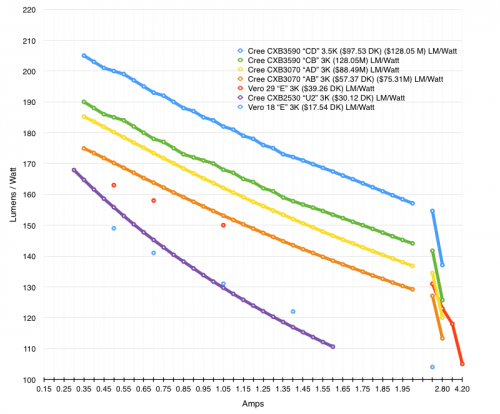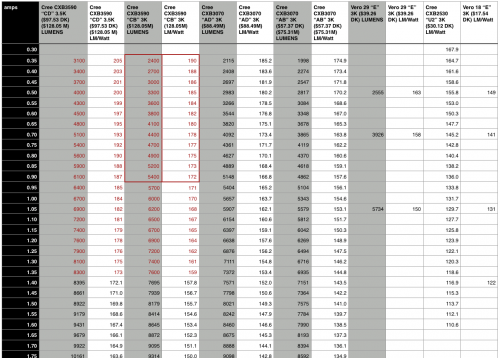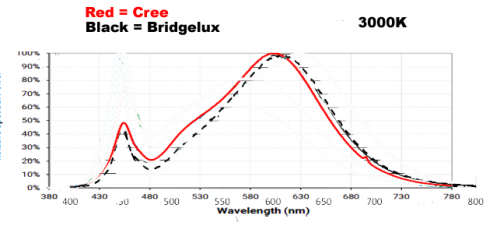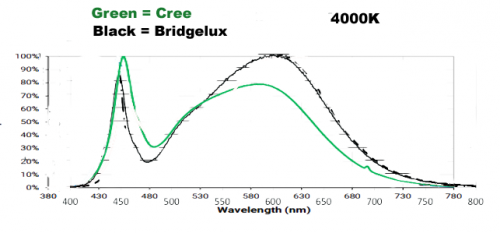Long story short, I had to kick some spruce seedlings out of the grow tent (peppers and tomatoes needed the space). If you’ve tried growing white or norway spruce, you know that to keep them from budding (and going dormant), they pretty much need 24/7 lighting.
I looked around for some efficient COB’s, and came across the Bridgelux Vero line, and the Cree CXB’s.
Now by “efficient”, I’m referring to lumens per watt. Plants don’t care as much about lumens (hence the saying “lumens are for humans”), so spectrum came into play also, but lumens are easy to work with and were as good a starting point as any.
To give an idea as to the ballpark we’re playing in when it comes to the Vero and CXB’s:
- A pretty efficient CFL on my desk provides 68 lm/W.
- An LED “60 Watt equivalent” bulb bought this year provides 85 lm/W.
- The Vero 29 gives between 123-163lm/W (technically you could push more or less).
- The Cree CXB3590 gives between 125-190lm/W (technically you could push more or less).
How well the Vero and CXB’s do depends on the current pushed through them. Run at a very low current, and the efficiency goes way up. You don’t get as much light, but you get more light per watt. You can go the other way and push very high current, get lots of light, but the efficiency goes down (less light per watt).
Anyway, I looked at the datasheets, collected the info, and started putting some numbers together. It’s a bit messy (remember this was for my own use), but here’s what it looked like visually:
Update: A few people have been linking to this post for the chart – please keep in mind that this post was written in Nov/2015 and thus the graph (and chart further down) are not for the newer “Gen 7” Veros which came about in 2016.
You can click for a larger image, but because a few things stand out like sore thumbs, here are a few notes:
- The top (blue) line is for the 3500K COB (it was the only one available in the “CD” bin). The higher color temp gives it a bit of a lumen/watt advantage.
- The Vero 29 (red) and Vero 18 (light blue) are just dots. The datasheet didn’t really have enough datapoints to really extrapolate stuff in between.
- At the far right (after 2 amps), the scale changes. It jumps to 2.1A, 2.8A, 3.15A, 4.2A
- These were for the best Cree “bins” available. By available, I mean ones that are actually stocked, that you could actually order today.
Generally speaking, the Cree’s come out ahead. However, you’ll notice something pretty interesting about the Vero 29, and it has to do with the bit on the right side. At the 2100mA mark, the Vero is actually more efficient than the CXB3070 “AB” (orange line) bin (actually, it’s more efficient well before the 2100mA mark). At 2800mA, it’s more effcient than the CXB3070 “AD” (yellow line) bin. Once you get to 3150mA, it ties the CXB3590 “CB” bin (not shown, but 118lm/W for both, though the “CD” bin stays ahead at 129lm/W at that point). Cree didn’t have any data for 4200mA, so it’s hard to know whether the Vero 29 manages to eventually pass it in efficiency.
Basically, the Cree CXBs are more efficient than the Vero 29 at low currents, while the Bridgelux Vero 29 starts to become more efficient than Crees at higher currents. Here’s a shot of the actual numbers in case you’re looking for a little more detail:
Again, click for a larger image. It’s again a bit of a mess, and here are a couple notes:
- The numbers in red were extrapolated (Cree’s tool didn’t list those ranges). The boxed red is probably even less accurate than the non-boxed red.
- Grey columns are the lumen output. White columns are the lumens per watt. I only listed the CXB2530 and Vero 18 because I wanted to compare the next “step down” at a glance (pricing and rough efficiency), so I didn’t bother with total lumen output for those.
Loose Strings
If the above numbers were written-in-stone and were all that mattered, that would be the end. Unfortunately, there are a lot of other factors that come into play. We’ll start by assuming that the datasheets and tools are honest and accurate, that I plugged things in correctly, and move on to….
Binning and minimums
Cree “bins” their LEDs. That’s where the numbers you see like “CB” and “CD” come in. That means the lm/W you see are probably pretty darn close (for those bins, anyway). That’s also why searching for a 3000K CXB3070 at a retailer might show 6 results at different prices. On the other hand, Bridgelux doesn’t bin. They simply list a minimum and a “typical” value. The numbers you see are from the “typical” value. So with the Vero, you could actually get less. Or if they’ve got a great process, or if you get lucky, you might get better than what’s stated.
Heat
The values I used are for 25˚C. Efficiency drops as temperature increases. Checking the Vero 29 and a couple CXB datasheets, it seems to be a 10-15lm/W drop (roughly) if you jump to 85˚C depending on the current. It didn’t look like either brand was hit significantly harder than the other by increasing temperatures, but I only checked a few random current values.
Wavelengths
This is more plant-related, but the spectrums used by the Vero / Cree LEDs differ a bit. While I used the 3000K models when gathering the data, the wavelengths that are used to arrive at that 3000K are slightly different. I Frankenstien-copy-pasted to mash the 2 relative comparisons from the datasheets together, and got this:
Let’s pretend that Bridgelux didn’t hand-draw theirs to begin with (or that their artist is more accurate than I would be), that both got it 100% accurate, and that I wasn’t terribly far off in my copy/paste/scale/stretch. The Cree seems to peak slightly higher in the blue, has a “bulge” containing a little more green (around the 520nm mark), and tapers from the red a little more quickly. Not a big difference either way.
But let’s look at what happens at 4000K.
Wow. Quite a bit different this time around! The Cree loses a lot of red, the red curve is shifted left (to more green), and it gains a chunk of blue. The Bridgelux on the other hand stays fairly close in overall shape to it’s 3000K brethren – the red “fattens out” toward the green, and the blue’s intensity is turned up quite a bit relative to the red.
Depending on how attached you are to specific wavelengths, the spectrum could factor in to your decision, particularly if you’re planning to run your LED at a current where both the Vero 29 and CXB3070/3590 are really close efficiency wise and you’re at the point of trying to tweak your level of red or blue.
Color Temps and CRI (continued from Wavelengths)
As you get to higher color temperatures, you’ll find that lumens per watt increases. The Vero handles this a little differently from the CXBs.
- For Veros (which aren’t binned), the spec sheet just plain shows increasing lumens per watt. A 3000K@500mA will manage 163lm/W. Move up to 5000K@500mA and you can hit 180lm/W.
- For the Cree leds, better bins simply become available. 3000K might be offered in AB bins, whereas 5000K might be offered in both AB and AD bins (we’ll assume in this case that AD is the higher one). That’s because the bin number for Cree is basically a measure of the lumen output.
Anyway, if you’re doing lighting for people, moving to a higher color temperature will increase the perceived brightness for the Vero line. It’ll open up “brighter” (higher lumen) bins for the Cree line. It’ll also make the light less red/orange in color (and eventually more blue if you go far enough), but if you’re just looking for absolute perceived brightness, you’ll probably notice higher lumens the further you go up the Kelvin scale.
If you’re doing lighting for plants, things get a bit more tricky. Remember than “lumens are for humans”. The lumen scale gives an advantage to green light. Most people growing plants focus on having a lot of red and blue light for some of the really efficient plant wavelengths (common aims being ~450nm blue, 630nm red, 660nm deep red). So a light that peaks high for plants often won’t show high on the lumen scale. That said, plants will use other spectrums (including green), and even the “McCree curve” (which is often considered the ideal spectrum for growing) has green in there. In any case, I wouldn’t fret too much over the lumen loss if you’re using a 3000K instead of a 5000K. Both may very well put out the same amount of light. It could just be that the 3000K is putting out the same (or more) – it’s just putting out more red and blue which the plant likes just fine, but that lack of green just happens to make it look worse on the lumen scale.
CRI is another bit to watch for. It stands for “color rendering index”. It’s basically a fancy way of saying how well/correctly the light displays colors. If your lighting is for human use, a higher CRI will usually result in lower lumens per watt, but the color of the room it lights up (and the stuff in it) should be more accurate. If going the plant route, going with a lower CRI usually makes more sense, because the lumens matter more – I don’t imagine the plant really cares whether the flower pot it’s in is being rendered in the correct color. An exception might be if something with a high CRI happens to tickle a certain wavelength you really think you need that the low CRI version doesn’t capture.
Mounting
The Vero line not only has holes built in for oh-so-quick-and-easy mounting, but the backing (which goes against the heatsink) is an aluminum substrate. I’ve installed a few, and was able to get the screws a little tighter than snug without much worry.
When it comes to the Cree, not only does it need separate hardware to screw-mount it, but the backing is a delicate ceramic substrate, which means depending on the mounting hardware you choose, you might have to be dead-careful not to over-tighten. Some of the aftermarket mounting kits (a 2-piece one I recently tried for example) are a pain to drill for due to hidden rear alignment pegs. The one I used also had uneven clamping pressure and not a lot of pressure to begin with due to a flex-tab.
Where efficiency comes into play is here: the tighter you can clamp the LED to the heatsink, the better the contact, and the better the thermal transfer. If you can’t get the Cree as tight against the heatsink (safely), it’ll potentially run a couple degrees higher, which means a little less efficiency. If you don’t get the mounting hardware at all (and just rely on the thermal interface material to hold it on), you’ll be in the same boat.
Again, not something likely to matter if you’re going to run a Cree at a current where there’s an easy win/loss against a Vero. Running the led’s “soft” (low current) will probably make this a non-issue too. But if you’ve picked a bin & current where they’re neck and neck, and if you’re expecting it to put out a good bit of heat or have undersized your heatsink, it’s certainly something that could come into play.
Lower Cree Bins, the CXA, and the Vero 1.0
I’ve used the 2nd generation Vero 29 in the chart above (part number ends in a 2X), and the highest available binned Crees. The reason is that older stuff and weaker bins virtually always lose.
It’s hard to find the “old” version of the Vero 29, so that’s usually not an issue. There are still an abundance of Cree CXA’s, and weaker binned CXB’s out there though. And when you compare the lm/W (even between bins), you’ll find a substantial drop each time you get older.
If you come across older stuff that’s discounted to a price hard to say no to, make sure to check the datasheet to see how it compares to the current generation model.
Lumens per dollar (efficiency when it comes to your wallet)
I’ve (hopefully) covered lumens per watt pretty well. And if we only looked at that, the high-bin Cree 3590’s would win in just about every circumstance. The one big exception would be heavily overdriving the LEDs at max current or higher.
The problem is that at some point, money usually comes into play.
You might have noticed the dollar amounts I had listed in the charts… the highest bin Cree was almost $130 (Canadian Dollars). For that price, I could get 3x Vero 29 ($40 each, so $120) with some money to spare for the fancy molex solderless plugs.
If you really need 180 lumens/watt, the Cree might be your only choice. However, if 160 lumens/watt would be okay, getting 3x Vero 29 could be a better deal. Here’s why:
- 3xVero29 (3000K) @ 600mA gives about 9600 lumens (160lm/W).
- 1xCXB3590 (3000K) @ 1325mA gives about 7500 lumens (160lm/W).
Not only are the 3 Vero’s cheaper, but you’ll get higher total light output – obviously more watts of power, but the same efficiency. If instead you wanted exactly 7500 lumens of output, you could run the Vero 29’s softer… 500mA (instead of 600mA) would give just over 7500 lumens at an efficiency of 163lm/W.
OKAY, SO THE VERO’S ARE A BETTER DEAL THEN, I SHOULD GET THOSE, RIGHT?
No, not so fast! Those Vero’s have to be powered. In series, they’ll need a driver capable of about 107 volts delivering 600mA. It’s tough to find DC drivers putting out that high of DC voltage. You could instead run them in parallel (~35-36 volts delivering 1800mA) which may be easier to find a driver for, but then you’d want to ensure they’re all heatsinked together in such a way that you minimize the likeliness of thermal runaway. Probably also a good idea to ensure you have a good enough heatsink/cooling system to handle it if 1 LED decides to power hog all 1800mA during a runaway drive.
Or, you could get 3 drivers. But now your cost just went up and the Cree might start looking like a better bargain.
—
…you can see where this is headed.
In any case, if you’re content with simply being way more efficient than you could ever find in a local store, the Vero’s are usually a great buy for the money. In situations where money’s less of an issue (and efficiency is of paramount importance), the Cree’s are probably the way to go.
For everything in between… pull out a pen and paper, figure out what’s most important to you, and get ready to start reading through some datasheets!




What spectrum differences when running soft and hard? Like, 4w of cree cxa delivers 6umols/sec @ 111lm/w . But how does running hard/soft shift the spectrum and umols/sec?
As I'm new to this , I intend to build with bridgelux due to price.
My question is, what's the minimum "quality"/grade drivers I need?
Here in Brazil mean we'll is hard and expensive to find.... For a first build, what's the cheap/safe drivers ?
I suppose if it's critical, you could email Bridgelux regarding color shift and the umols/m2/sec. If they give you results @ their "nominal drive current" for umols/m2/sec, you should be able to use their datasheet to roughly math out the umols/m2/sec at the current you intend to drive at.
---
As to drivers, might be worth checking eBay for some Mean Wells - if you get a legit source, you might find them a little cheaper than standard retail. Otherwise, I've used cheap generic eBay drivers too: they'll usually produce less current than they claim, but if you can find a way to keep them cool during operation, they'll stand a reasonable chance of surviving long term. Whether they're safe or not is an entirely different story - don't assume that just because it has a ground wire that the wire is actually connected to anything - it might not be. You either have to check yourself, or design your enclosure for a worst-case-scenario.
When it comes to the generic eBay drivers, I usually do the latter and assume "at some point this driver will short internally to the casing and try to electrocute me. if that doesn't work, it will start on fire and try to get me that way". Design around that. Manually ground things, use GFCI-protected outlets, and make sure whatever you built will handle the high temps of a fire (and contain the fire). You'll sleep a little more soundly.
Hope something in there helps!
My main concern about cheap drivers(not considering safety/fire), is that a rated 30-38v 1800ma driver, may deliver 1500ma and that's "ok". I'm worried about the driver not putting out 38v... The vero 29 at low currents need like 36-37v, but what's the "operational issues" for the vero 29 if the driver max voltage is actually 34 or 35v? I just can't trust a 1800ma 40v driver that is labeled as 60w....
And, I found dc-dc boosters on eBay,12v input and 38v @1500ma(rated 50w) output. Any comments?
Cheers
I'd trust a legit Mean Well (or other branded driver) to come close to it's max voltage listing. For the unbranded eBay stuff though, I aim for the lower end of the voltage range when sizing things up. In your example of a 30-38v driver I'd only use an LED expected to pull in the 31-35v range (31 instead of 30 because if the driver pushes less current it'll drop the voltage characteristics). If possible, I'd try to find a driver with a wider listed voltage range though, since a tight voltage range gets frustrating because you're almost forced to pick an LED based on the driver.
As to DC-DC boosters, I've never used them myself, so I can't give much in the way of advice there. If I were going that route, I suppose I'd use the 12v rail of a computer PSU (since I've got a bunch kicking around), grab a cheap dc-dc converter, grab the multi-meter, and start experimenting.
I bought a lot of Meanwell drivers a couple of months ago and offer some of them for sale to you. I run an LED light manufacturing company in the US and have extra if you like. The model is the HLG-185-42A. You can easily run these 5 years without a problem and just two or more VERO 29s in parallel. It's adjustable up to 42V at 4.4A.
I've been trying to find afordable vero 29 drivers, but due to drivers price, I might end up going with vero 18(27-34v) , and running them at 1800ma(1050ma typical) with a good cpu cooler....
Not that efficient, but the overall upfront cost is smaller....
What about lens? I think I might go 120degrees, but what about 90degree?
Opticgrowlights is my benchmark.....
Vero 29's are indeed on the pricy side, and their higher voltage makes it a little harder to get a driver for. I've got a Vero18 running happily on an eBay driver (where aVero 29 strobed on it), so from a cost standpoint the Vero 18 is much easier to work with. Of course, you do eat an efficiency hit and you're not going to be pumping out the same lumens as you would with the higher-voltage Vero 29 at the same current level either: even ignoring the lumen loss from the efficiency hit, the lower voltage itself results in less wattage.
On lenses: if you're talking about a separate lens, I tend to avoid them unless humidity/water/lens_protection are an issue because they'll block some percentage of light.
If you're using them though, with a wider beam angle you can get closer to the plant canopy at a given coverage area. With a narrower beam angle you'll end up with a smaller coverage area at the same height but more intensity and a little more light penetration. If whatever you grab ends up being less-ideal-than-you-predicted, note that you can usually use reflectors to change a wider beam angle to something a little more targeted (with some losses from imperfect reflectivity), and can always raise a narrow-beam-angled light to increase the coverage area (with loss in the form of reduced intensity at canopy level).
But about lenses, recently I was looking at roll it up and I saw some measurements from vero 29 and cxa3590 with 90-120-no lenses-reflector. And I started to believe that you have lens loss(10%max), but the gains in penetration and intensity(light concentration) might be bigger than the loss....
But I might end up with reflectors...
(Hits te blunt:) project and 3d print a custom reflector to create an even canopy... Then Mylar it... Haha
You could certainly plot against wattage instead if you wanted, and indeed that would perhaps be more helpful if you're looking to compare LEDs running within a certain total power envelope (ie find efficiency of a number of LEDs being run at around the 50W point at a typical temperature). I didn't do it in the above simply because that wasn't the primary purpose and using current tends to be the standard.
The higher CRI appears to have more deep reds, but really it is an illusion created by the relative nature of the spectrum graph.
In reality the 90 CRI version is just a 80 CRI with less power output for yellow, green and blue.